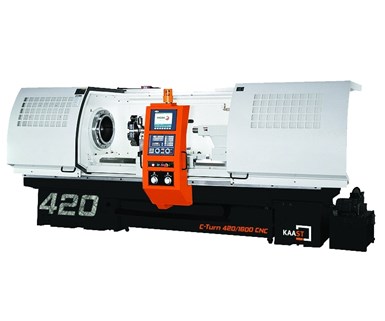Kaast's C-Turn Teach-Style Lathes Feature Vibration-Damping Construction
Lathes in Kaast Machine Tools’ C-Turn series are made with high-tensile-strength Meehanite castings for vibration damping.
Share







Lathes in Kaast Machine Tools’ C-Turn series are made with high-tensile-strength Meehanite castings for vibration damping. These teach-style lathes can repeat long strings of directions for multiple reproductions. The Fagor 8055i/A TC control panel provides a conversational graphical interface which does not require the user to have a prior CNC programming or G-code background, the company says. For those who wish, programmable logic and ISO (G-code) control are also fully integrated.
All slide ways and drive elements are automatically lubricated, and the undersides of the saddle and the cross slide are coated with Turcite-B to ensure accuracy and long component life. The headstock also features forced lubrication and an oil bath.
The main spindle bores, machined and ground from a single forging, range from 3" to 14". Double-chuck systems are also available. The spindle and gears are made of carburized and ground CrMO steel. The three-point support on the spindle is said to ensure accuracy and rigidity. Three automatic toolchanger systems are available as options (H4, V8 or V12). The lathes also include a built-in tool library for easier tool management.
C-Turn lathes have electronic hand wheels for manual operation, with a simple and intuitive DRO mode, the company says.
Related Content
-
Second B-Axis Improves Efficiency of Swiss-Type Machining
A highly stable, fully programmable B-axis on the subspindle of Nomura DS’s 20J3XBTC enables users to more quickly machine complex parts complete.
-
Inverting Turning and Five-Axis Milling at Famar
Automation is only the tip of the iceberg for Famar, which also provides multitasking options for its vertical lathes and horizontal five-axis machine tools.
-
Inverted Milling Offers Power in a Compact Machine
To compete in terms of stability and horsepower, Modig’s recent IM-8 mill takes an unorthodox approach: positioning the spindle at the bottom of the work area.














